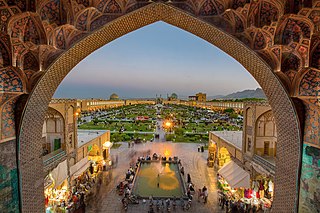
Isfahan, from its ancient designation Aspadana and, later, Spahan in middle Persian, rendered in English as Ispahan, is a major city in the Central District of the Isfahan Province of Iran. It is located 440 kilometres south of Tehran and is the capital of Isfahan Province. The city has a population of approximately 2,220,000, making it the third-largest city in Iran, after Tehran and Mashhad, and the second-largest metropolitan area.

Abu Ja'far al-Mansur ibn al-Faḍl al-Mustarshid bi'llah usually known by his regnal name Al-Rashid bi'llah was the Abbasid caliph in Baghdad from 1135 to 1136. He succeeded his father al-Mustarshid in the year 1135. He ruled for just one year from 1135 up to his deposition on 17 August 1136. When the populace of Baghdad rose in revolt against him.

Iranian architecture or Persian architecture is the architecture of Iran and parts of the rest of West Asia, the Caucasus and Central Asia. Its history dates back to at least 5,000 BC with characteristic examples distributed over a vast area from Turkey and Iraq to Uzbekistan and Tajikistan, and from the Caucasus to Zanzibar. Persian buildings vary from peasant huts to tea houses, and garden pavilions to "some of the most majestic structures the world has ever seen". In addition to historic gates, palaces, and mosques, the rapid growth of cities such as the capital Tehran has brought about a wave of demolition and new construction.

Naqsh-e Jahan Square, also known as the Shah Square prior to 1979, is a square situated at the center of Isfahan, Iran. Constructed between 1598 and 1629, it is now an important historical site, and one of UNESCO's World Heritage Sites. It is 160 metres (520 ft) wide by 560 metres (1,840 ft) long. It is also referred to as Shah Square or Imam Square. The square is surrounded by buildings from the Safavid era. The Shah Mosque is situated on the south side of this square. On the west side is the Ali Qapu Palace. Sheikh Lotf Allah Mosque is situated on the eastern side of this square and at the northern side Qeysarie Gate opens into the Isfahan Grand Bazaar. Today, Namaaz-e Jom'eh is held in the Shah Mosque.
Zavareh is a city and capital of Zavareh District, in Ardestan County, Isfahan Province, Iran. At the 2006 census, its population was 7,806, in 2,197 families.

Khansar is a city in Isfahan province of Iran and the center of Khansar county. The history of Khansar dates back to pre-Islamic times. "Khan" meaning spring and "Sar" suffix indicate plurality. In the past, this name was given due to the abundance of springs in this region. Khansar people have an independent Khansari dialect that has its roots in the ancient Persian language and has been common in this region before Islam. According to the official census of 2016, the population of Khansar city was 21,883.
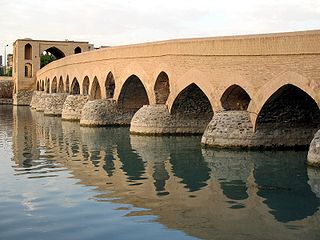
The Shahrestan bridge is the oldest bridge on the Zayandeh River in Iran. The foundations date back to the Sasanian era, but the top was renovated twice, first in the 10th century by the Buyids, then during the 11th century during the Seljuk period. Nevertheless, the architectural style is entirely Sassanian.
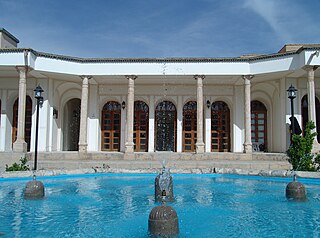
Khomeyni Shahr is a city and capital of Khomeyni Shahr County, Isfahan Province, Iran. At the 2006 census, its population was 218,737, in 57,551 families.
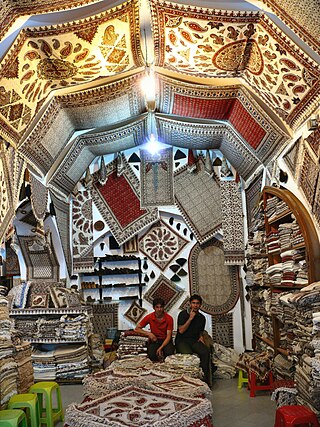
The Grand Bazaar is a historical market located in Isfahan, Iran, also known as the Qeysarriyeh Bazaar, Qeysarie bazaar or Soltani bazaar. The main commercial activities in the Qeysarie bazaar are carpet and kilim selling.

Emamzadeh Esmaeil is a historical complex in Isfahan, Iran, which dates back to the Seljuk and Safavid era. This complex is located near the Jameh Mosque of Isfahan, in the Hatef street and contains two mausoleums, one believed to be for Esmaeil, one of grandsons of Hasan ibn Ali, and another which is believed to be Isaiah's.

Al-Rashid Mausoleum is a historical mausoleum in Isfahan, Iran. It dates back to the Seljukid era and is located on the northern bank of Zayanderud beside the Shahrestan bridge. This structure is the burial place of Al-Rashid, the 30th Abbasid caliph, who left his palace and fled from Baghdad to Isfahan, when Mahmud II captured Baghdad. Two years later, Al-Rashid was stabbed and killed by Hashshashins in 1138. The only decorative element of the mausoleum is a stucco Kufic inscription.
The Jameh Mosque of Khozan is a historical mosque in the Khomeyni Shahr County of the Isfahan Province. The original building of the mosque dated back to the Timurid era in the 15th century, but it's improbable that the current building to be older than the Safavid era. The mosque has four iwans. The southern iwan leads to the inner space of the dome. The inner space of the dome is decorated by muqarnas. The walls of the mosque are covered by stones and bricks. The arches of the northern and southern iwans are decorated with some paintings from the Safavid era., but the paintings of the eastern and western iwans seem to belong to the Qajar era. The shabestan of the mosque is behind the western iwan. There are 20 stone columns with the height of 2 m in the shabestan. The shabestan had been lit originally with the marble stones of the ceiling, but during the recent reparations, these marble stones have been removed.
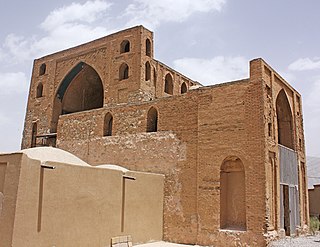
The Pir Bakran mausoleum is a historical mausoleum in Pir Bakran, the capital of Pir Bakran District. The mausoleum dates back to the Ilkhanid era. The names of The Rashidun Caliphs on its inscriptions show that the building belongs the early times of the conversion of mongols to islam and they were still sunnite. The courtyard of the mausoleum is surrounded by walls, small iwans and the arched portals of the main iwan and decorated by some inscriptions with Kufic scripts and stuccoes with the form of flowers and bushes, which are the works of Mohammad Naghash. Mohammad ebn-e Bakran's grave is located behind the courtyard. On the northern side of it, there's a small closed room, which was probably his teaching place. The mausoleum is decorated with stuccoes and tiles.
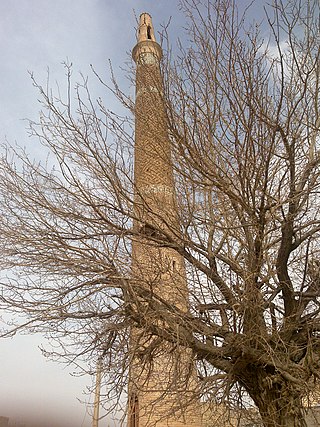
The Rahrovan minaret is located 6 km northeast of Isfahan in Raran, Iran. The minaret is 30 m high. It dates back to the Seljuq era and has almost kept its original shape, but its inscriptions has been damaged severely. It is the fourth oldest minaret in Isfahan province after Ali minaret, Sarban minaret and Ziyar minaret. Its decorations are simple, featuring a stripe of rhombic shapes around the minaret, in which the names of Mohammad and Ali are repeated. On the top of the minaret, there is a window for muezzin and signal fire for orientation of caravans and passengers in the desert.
The Gar mosque and minaret are historical structures located in Gar village in the Isfahan province. The minaret dates back to Seljuq era, but the mosque belongs to the Ilkhanid age. The only remained part of the mosque is its mihrab, which has been decorated with stuccoes, but the minaret is relatively in a good condition and according to its inscription, it was built in 1121 by Abolghassem ebn-e Ahmad.

The Kaj Mosque is a historical mosque in the Isfahan province, in Iran. The mosque is located 24 km east of Isfahan on the northern bank of Zayandeh Rud. From the mosque, it is remained now only some half-ruined walls and a dome. It dates back to the Ilkhanid era. Brick is the most important construction material for this structure and even the inner decorations are of bricks. The mosque had probably a minaret in the past, but there is no trace of it now.

The Hafshuye Mosque is a historical mosque in the Isfahan province, Iran. It dates back to the seljukid era. The main part of the mosque, especially its dome, has been destroyed and its wall has been damaged. The structure has been built mainly with adobes, but its facade has been worked with bricks.
Mohammad Reza Emami was a Persian calligrapher in the 17th century. He lived from the era of Abbas I until the era of Suleiman I. He was Ali Reza Abbassi's student and was known as the Imam of calligraphers.

The Izad Khast Castle is located in Izadkhast in the Fars Province, central Iran. The castle was built during the Sassanid Empire and functioned as fortified walled city on the ancient Silk Road that ran through central Iran. It is the second largest adobe building in the world after Arg-e Bam.















